Wednesday 4 March 1942
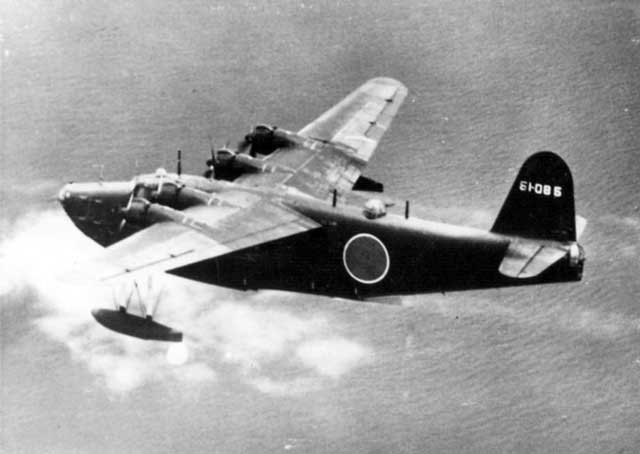 |
| A Japanese Kawanishi H8K is seen seconds before being shot down by a Navy aircraft in July 1944. COURTESY OF THE U.S. NAVY. |
Battle of the Pacific: One of the forgotten facts of World War II is that there was not just one Japanese raid on Oahu, Hawaii, but two. Everyone remembers the 7 December 1941 raid on Pearl Harbor, but the
4 March 1942 raid is lost in the mists of time. It thus makes for a good trivia question if you are determined to stump someone who claims to know "everything" about World War II. Late on 3 March, two Kawanishi H8K "Emily" flying boats depart their refueling station at the French Frigate Shoals (refueled by submarines HIJMS I-15 and I-19) and embark on Operation K. They fly the 560 miles (900 km) to Oahu armed with four 250-kg (550 lb) bombs each. As on the first raid, US radar stations pick up the two approaching planes. This time, rather than ignoring them, the USAAF sends up Curtiss P-40 Warhawk fighters to intercept them and also Consolidated PBY Catalina flying boats to seek out their presumed aircraft carrier source. However, the weather is poor, and the US planes find nothing. The Japanese planes thus reach Oahu unmolested.
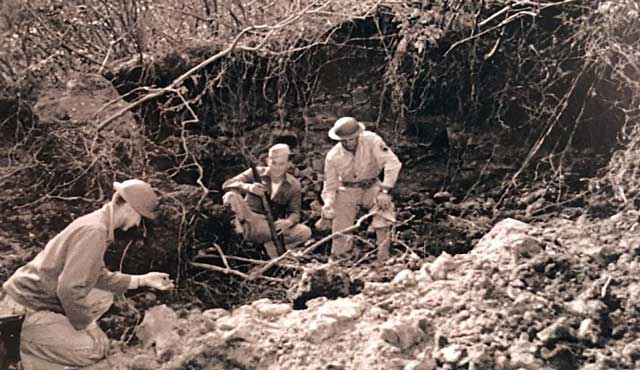 |
| Soldiers inspect a crater left near Honolulu after a Japanese bombing raid on Hawaii, March 4, 1942, in this undated photo on display at the Pacific Aviation Museum in Honolulu. WYATT OLSON/STARS AND STRIPES. |
The huge Japanese planes approach through a heavy cloud cover at 15,000 feet (4600 m). The Japanese pilots spot the Kaena Point lighthouse and their leader, Hisao Hashizuma, decides to attack from the north - the same direction as on 7 December 1941. However, for some reason, the crew of the other plane, commanded by Ensign Shosuke Sasao, does not hear this plan and instead approach Pearl Harbor from the south. Hashizuma cannot see through the clouds and the blackout on the island gives him no reference points. He winds up dropping his bombs at about 02:00 on the slopes of Tantalus Peak. These bombs shatter some windows at a nearby high school (Theodore Roosevelt High, which is still there) and create some craters nearby. According to eyewitnesses, this wakes up everyone in Honolulu. It is unclear where the second plane drops its bombs, either over the ocean or some uninhabited land. The two flying boats then slip away to the southwest, and Hashizuma returns to Jaluit Atoll in the Marshall Islands while the second plane lands at nearby Wotje atoll.
 |
| HMAS Yarra, sunk by Japanese cruisers on 4 March 1942. |
Due to its lack of impact, this second raid on Hawaii becomes a footnote to history. However, it is a tremendous technical achievement and does have an impact. By flying from the French Frigate Shoals to Oahu, executing his attack, and then returning to Jaluit, Hashizuma successfully completes the longest bombing raid in history up to this point. The raid causes massive confusion in the United States, with the military claiming that it had dropped the bombs at Tantalus while a spurious Los Angeles radio news report claims there were 30 dead and 70 wounded. The Japanese, meanwhile, remain quite pleased with the raid despite not causing any real damage or obtaining useful visual data. They plan another one as soon as it can be readied. On 10 March, Hashizuma and his crew will also carry out that raid, but they are shot down near Midway Atoll. Propaganda broadcasts about the raid from Tokyo lead the US Navy to secure the French Frigate Shoals to prevent future attacks by stationing a destroyer there for the remainder of the war.
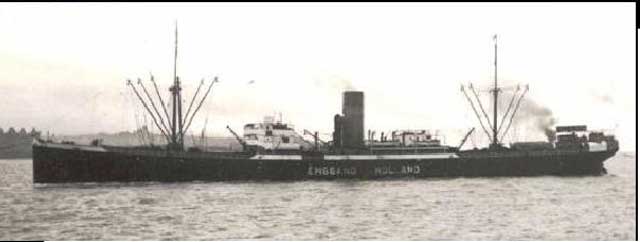 |
| Dutch freighter Enggano, sunk by Japanese cruisers near Java on 4 March 1942. |
At Java, Netherlands East Indies, the Dutch are busy blowing up installations of strategic importance as the Japanese advance. Blackforce, a unit composed of a hodgepodge of units from all the Allied combatants but principally Australian, withdraws from Buitenzorg to Sukabumi, about 30 miles to the south. A top Japanese priority is the capture of the port of Tjilatjap on the south coast, from which Allied ships have been leaving for Australia, but that is not directly threatened yet.
 |
| A Douglas SBD-3 Dauntless ready for delivery at Douglas Aircraft Company's El Segundo, California (USA), plant on 4 March 1942. This is the type of plane used during the raid on Marcus Island (US Navy National Naval Aviation Museum). |
At 06:30, Vice-Admiral "Bull" Halsey's Task Force 16 attacks Marcus Island (about 725 miles northwest of Wake Island). Launched from
USS Enterprise, 32 SBD Dauntlesses along with 6 F4F Wildcats fly through some heavy antiaircraft fire, losing one SBD whose crew is captured. Marcus Island is within 1000 miles of Japan, which is closer than it may seem in the Pacific.
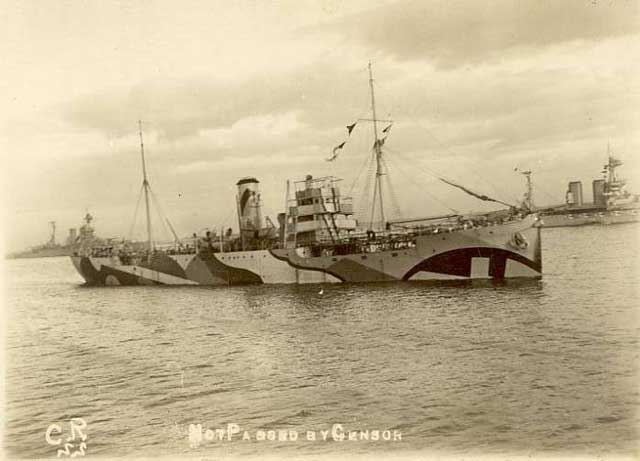 |
| Tanker Francol, sunk south of Java on 4 March 1942. |
The Japanese Navy continues its depredations against Allied ships evacuating Java. Heavy cruisers HIJMS Atago, May, and Takao, accompanied by two destroyers, pounces on a convoy of three merchant ships (depot ship Anking, tanker Francol, and minesweeper MMS.51)) escorted by Australian sloop HMAS Yarra. The convoy has left Tjilatjap, Java, bound for Fremantle, Australia. By about 08:00, all four ships are sunk. Of the 151 sailors aboard Yarra, only 13 survive (they are rescued by a Dutch submarine on 10 March). There are two survivors of Francol, 14 survivors from MMS.51, and 57 survivors of Anking (several of whom perish from exposure within days of being rescued). The Japanese also capture an unnamed freighter which is not officially part of the convoy but sailed at the same time and remained near it. There are other naval encounters south of Java in which Japanese heavy cruiser Chikuma and destroyer Urukaze sink 5412-ton Dutch freighter Enggano. Japanese submarine I-7 torpedoes and sinks 3271-ton Dutch freighter Le Maire near Cocos Island and uses its deck to sink 865-ton Dutch freighter Merkus in the same area.
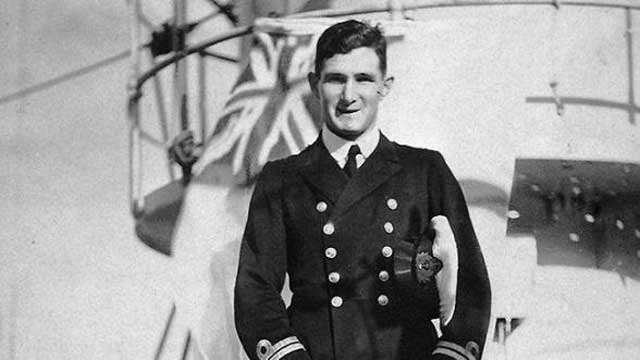 |
| Lieutenant Commander Robert Rankin, commander of HMAS Yarra, who goes down with the ship on 4 March 1942. |
The Allies do have some naval successes today. Four U.S. Navy destroyers that left Surabaya late on 28 February arrive in Fremantle. The four ships of DesDiv 58 (USS John D. Edwards, John D. Ford, Alden, and Paul Jones) wisely avoided battle in the Bali Strait and are some of the very few Allied warships to escape intact from Java. US Navy submarine USS-S-39 (SS-144, Lt. J. W. Coe) torpedoes Japanese oiler Erimo south of Beltung Island (the oiler's captain beaches it, but it is a total loss), while US submarine Grampus (SS-207) torpedoes and sinks Japanese tanker Kaijo Maru No. 2 about 145 miles south of Truk. Numerous Allied ships arrive at Colombo in the Indian Ocean, including battleship Ramillies and several destroyers.
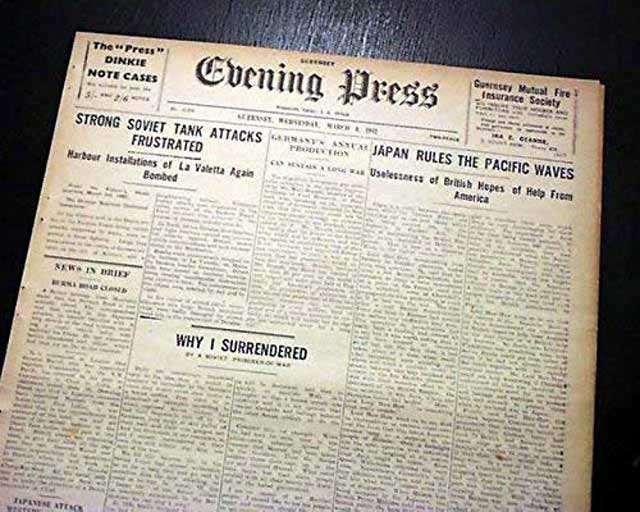 |
| The German occupation newspaper on the Channel Island of Guernsey dated 4 March 1942 is full of good news for the Axis, such as "Japan Rules the Pacific Waves" and "Strong Soviet Tank Attacks Frustrated." |
In the Philippines, the front along the Bataan Peninsula remains quiet as the Japanese continue building up their forces for a major offensive. General Douglas MacArthur (now holed up in the bunkers on the fortified island of Corregidor, which is often under air attack) is under orders to depart for Australia. Before he leaves, he reorganizes his command. He divides the Composite Visayan-Mindanao Force into two separate commands, with the Mindanao portion under Brigadier General William F. Sharp and the Visayan force under Brigadier General Bradford G. Chynoweth. General MacArthur's departure date to Australia is set for 14 March 1942.
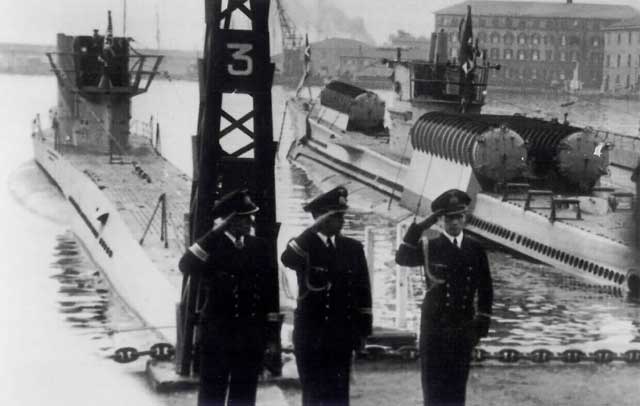 |
| Italian Navy officers at La Spezia, 4 March 1942. |
Eastern Front: The German Fourth Army complete their evacuation of Yukhnov following Hitler's unexpected approval on 1 March. The men head for a new line behind the Ugra River which offers better defensive possibilities but is still a tenuous position. While this problem is "solved," the Germans still have bigger problems, one of which is the trapped garrison under the command of Generalmajor Theodor Scherer at Kholm. A relief force under Generalmajor Horst von Uckermann is almost within sight of the garrison but is stuck in deep snow and blocked by heavy Soviet tanks. The Luftwaffe finds it difficult to help Uckermann to move forward because the Soviet defenses are concealed under snow. As often happens in these types of situations, Uckermann begins attracting negative comments from the Luftwaffe, almost certainly to shield their own ineffectiveness from Hitler. They make the usual complaints that he isn't aggressive enough and "lacks confidence." On the Soviet side, Stalin is fixated on restarting his counteroffensive and places a priority on Second Shock Army and Fifty-fourth Army taking Lyuban. The Germans intend to save Lyuban by moving in behind these two armies by retaking the line of the Volkov River in proposed Operation Raubtier. However, the troops need at least another week to build up sufficient strength to surround the attacking Soviet troops.
 |
| Firefighting in Boulogne-Billancourt after air raid of 3-4 March 1942. Source: Archives municipales de Boulogne-Billancourt. |
European Air Operations: RAF Bomber Command begins a four-day period of inactivity today as it recuperates from its all-out attack on the Billancourt Renault Factory on the night of 3/4 March. While the RAF loses two bombers during the night, this is an "acceptable" loss ratio of 0.8%.
A Free French soldier from Billancourt, Georges Gorse, pens an article for the British press which praises the raid despite the inevitable French civilian deaths, writing:
If we want the liberation of France, we must clench our teeth and accept that the British must bomb occupied Paris just as the Germans bombed London and that some French people will die under those Allied bombs. They are German casualties just as much as casualties during the 1940 campaign and the men shot by the Germans at Nantes and Paris. Boulogne-Billancourt workers rightfully see the March raids as a promise of liberation. Those who have perished have contributed to the war effort.
Gorse is elected mayor of Billancourt after the war.
 |
| A cropped photograph of the USS Hobson off Charleston, South Carolina, 4 March 1942. She is painted in camouflage Measure 12 (Modified). This photograph has been censored to remove radar antennas atop her foremast and Mark 37 gun director (Official U.S. Navy Photograph NH-53548, from the collections of the Naval Historical Center.). |
Battle of the Atlantic: It is a fairly quiet day in the North Atlantic. British 3915-ton freighter Gypsum Prince collides with fellow freighter Voco about 4 miles off Lewes, Delaware. British 6675-ton freighter Frumenton hits a mine and sinks near Orfordness.
There is a report published in the NY Times that "an enemy vessel, presumably a submarine," shelled the cliffs of Mona Island, about fifty miles southwest of Puerto Rico on 3 March. However, there is no confirmation from any other source that this actually happened. The paper touts this as the "First Land Attack on Us in Atlantic Waters."
 |
| A soldier's dog looks after his master's boots and rifle while he takes a shower provided by a mobile bath unit in the Western Desert, 4 March 1942. © IWM (E 9068). |
Battle of the Mediterranean: Malta remains under heavy Axis air attack throughout the day. The War Office today places Malta under the direct supervision of Middle East Commander General Claude Auchinleck, with General Dobbie, the Malta commander, now reporting to him rather than directly to the War Office. There is a hint of annoyance in the telegram to Dobbie which suggests that his daily complaints about lack of supplies and military resources on the island led to this change. Dobbie remains as governor for the time being.
War Crimes: The Japanese conclude the Sook Ching massacre in Singapore. This elimination of ethnic Chinese considered potential threats or simply inconvenient began on 18 February and results in many thousands of deaths (actual totals are just estimates). This leads to bitter resentment by locals against both the Japanese who actually commit the crimes and the British for not doing enough to prevent them or later punish those who committed them. There is a war crimes trial after the war which is widely considered unsatisfactory for failing to dispense adequate punishments. The Sook Ching massacre influences events in Singapore for decades and remains a lingering issue.
US/Canadian Relations: The US and Canada sign a
treaty "for the avoidance of double taxation."
 |
| Japanese freighter Erimo, sunk by a US Navy submarine on 4 March 1942. |
Japanese Military: Flush with success, the Japanese High Command begins expanding the map of conquest. Its new targets include New Guinea, the Solomon Islands, the Fiji Islands, and American Samoa. Most of these new objectives have little economic value, unlike the oil-rich Netherlands East Indies. The Japanese aim is to create a far-flung defensive perimeter to protect the homeland from any US Navy strikes in which to establish the Greater East Asia Co-Prosperity Sphere.
US Military: Lieutenant General Joseph Stilwell establishes the Headquarters, American Army Forces, China, Burma, and India, at Chungking. It is staffed by Stilwell's U.S. Task Force in China and the American Military Mission to China (AMMISCA) personnel.
The USAAF Fifth Air Force in Australia continues its frantic reorganization following Japanese advances in the region, including the imminent fall of Java. The 11th and 22d Bombardment Squadrons of the 7th BG (Heavy) arrive in Melbourne, Australia, from Jogjakarta, Java. Also arriving at Melbourne are the air units (B-17s, B-24s, and LB-30s) of the 14th Bombardment Squadron, which is attached to the 19th Bombardment Group (Heavy), and the air units of the 28th Bombardment Squadron, 19th BG (Heavy, which left Singosari, Java. The ground units of most of these units remain trapped at Java or Bataan, Philippines, with little hope of rescue.
Canadian Military: The US/Canadian buildup of forces in the British Isles continues. The first 40 Canadian Cruiser Tank Mk. I Rams arrive in England today.
 |
| Jenny Jugo on the cover of Filmwelt Magazine, Germany, 4 March 1942. Jugo began acting for UFA in 1924, and by this point, she was a well-established star. Her career faded out after World War II and she retired in 1950. Jenny Jugo passed away in 2001 at the age of 97. |
German Government: Either Adolf Hitler or Martin Bormann, Hitler's private secretary, sees a seemingly innocuous news item in the newspaper. It causes Bormann to fire off a sharply worded letter today. Bormann sends it to the head of the Reich Chancellery Hans Lammers, telling him that the Fuhrer noticed that the German Society for Mammalogy, which has passed a resolution changing the official names for bats and shrews. The name for bats has been shortened from Fliedermaus to Flieder, while the name for bats has been shortened from Spitzmaus to simply Spitz. Bormann writes:
The Führer subsequently instructed me to communicate to the responsible parties, in no uncertain terms, that these changes of name are to be reversed immediately. Should members of the Society for Mammalogy have nothing more essential to the war effort or smarter to do, perhaps an extended stint in the construction battalion on the Russian front could be arranged.
The changes are reversed immediately, and on 1 July 1942 the Society goes further and issues instructions that "terms that have become established over the course of many years are not to be altered."
US Government: The House of Representatives
authorizes the construction of a "free highway bridge" from Needles, California. across the Colorado River to Arizona.
Canadian Homefront: All people of Japanese racial origin are told to leave the protected area of a 100-mile wide strip along the west coast of British Columbia. They are told to pack a single suitcase and proceed to waiting areas where trains will arrive to take them to the interior. These sealed trains arrive sporadically over the course of several months, and until then, the refugees are held in places such as local livestock buildings. All property that they leave behind, including homes and cars, will be sold at auction.
American Homefront: The Rock End Hotel of Northeast Harbor, Maine, burns to the ground. A very popular hotel, it lasted for 60 years. No cause for the fire is identified.
The first assembly line of the Arkansas Ordnance Plant (AOP) is completed. This is one of the first plants of its kind in the country, and the majority (about 75%) of production line workers will be women. By November 22, 1943, there are 14,092 employees at AOP. The plant is closed completely by early 1946, but in the 1950s part of it is absorbed into the Little Rock Air Force Base.
Future History: PT-109, a PT-103 class motor torpedo boat, is laid down on 4 March 1942 in Bayonne, New Jersey. Built by the Electric Launch Company (Elco), it is launched on 20 June 1942 and serves in the Pacific Theater of Operations. PT-109 becomes famous when future President John F. Kennedy writes about his adventures relating to PT-109 before and after its sinking on 2 August 1943. It also is the title of a 1963 motion picture depicting the life of JFK.
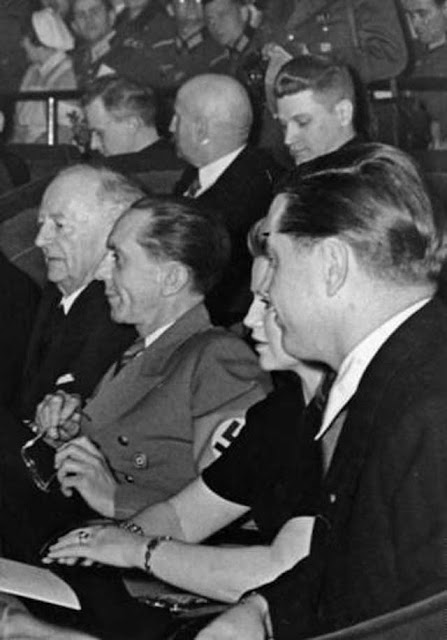 |
| Joseph Goebbels at the world premiere at Ufapalast of "The Great King," 4 March 1942. Goebbels is the head of the German film industry. Also visible are Christina Söderbaum and Dr. Hippler (Schwahn, Ernst, Federal Archive Bild 183-J00575). |
March 1942March 1, 1942: Second Battle of Java SeaMarch 2, 1942: Huge Allied Shipping Losses at JavaMarch 3, 1942: Japan Raids Western AustraliaMarch 4, 1942: Second Raid On HawaiiMarch 5, 1942: Japan Takes BataviaMarch 6, 1942: Churchill Assaults Free SpeechMarch 7, 1942: British Defeat in BurmaMarch 8, 1942: Rangoon Falls to JapanMarch 9, 1942: Japanese Conquest of Dutch East IndiesMarch 10, 1942:US Navy attacks Japanese Landings at LaeMarch 11, 1942: Warren Buffett's First Stock TradeMarch 12, 1942: Japan Takes JavaMarch 13, 1942: Soviets Attack In Crimea Again March 14, 1942: The US Leans Toward EuropeMarch 15, 1942: Operation Raubtier BeginsMarch 16, 1942: General MacArthur Gets His RideMarch 17, 1942: MacArthur Arrives in AustraliaMarch 18, 1942: Japan Attacks In BurmaMarch 19, 1942: Soviets Encircled on the VolkhovMarch 20, 1942: "I Shall Return," Says MacArthurMarch 21, 1942: Germans Attack Toward DemyanskMarch 22, 1942: Second Battle of SirteMarch 23, 1942: Hitler's Insecurity BuildsMarch 24, 1942: Bataan BombardedMarch 25, 1942: Chinese Under Pressure in BurmaMarch 26, 1942: Win Or Die, Vows MacArthurMarch 27, 1942: The Battle of SuusariMarch 28, 1942: The St. Nazaire Commando RaidMarch 29, 1942: The Free Republic of NiasMarch 30, 1942: Japanese-Americans Off Bainbridge IslandMarch 31, 1942: Japanese Seize Christmas Island
2020
















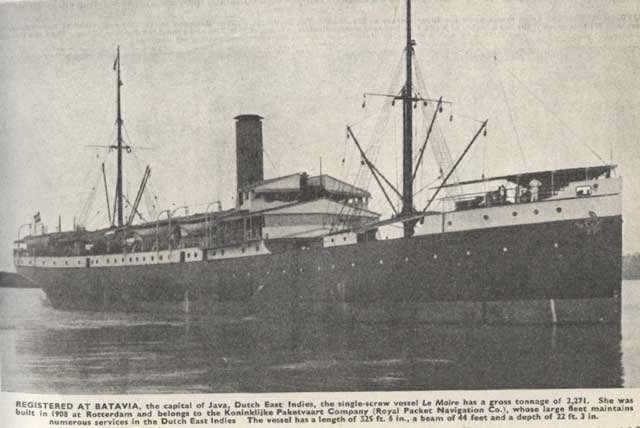
No comments:
Post a Comment